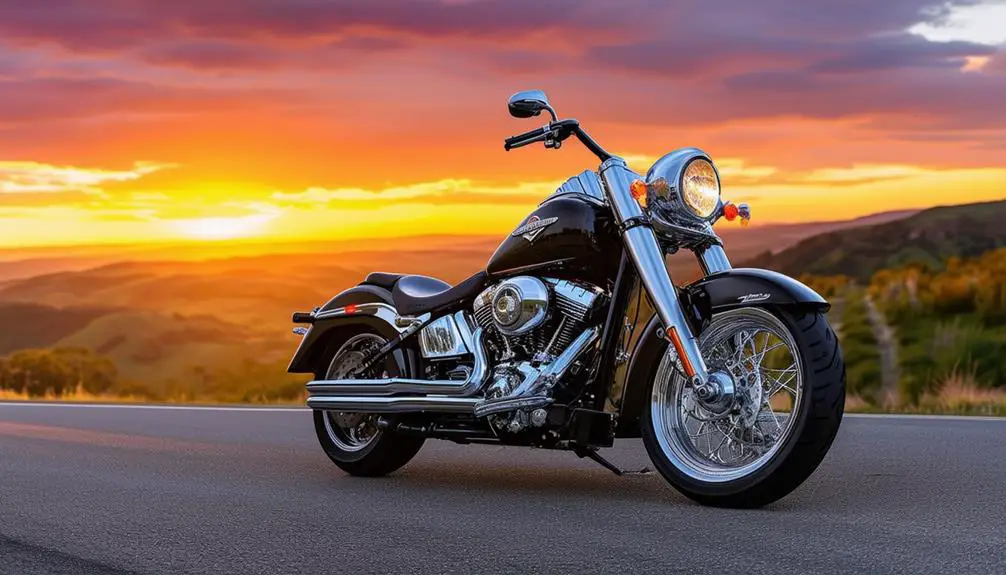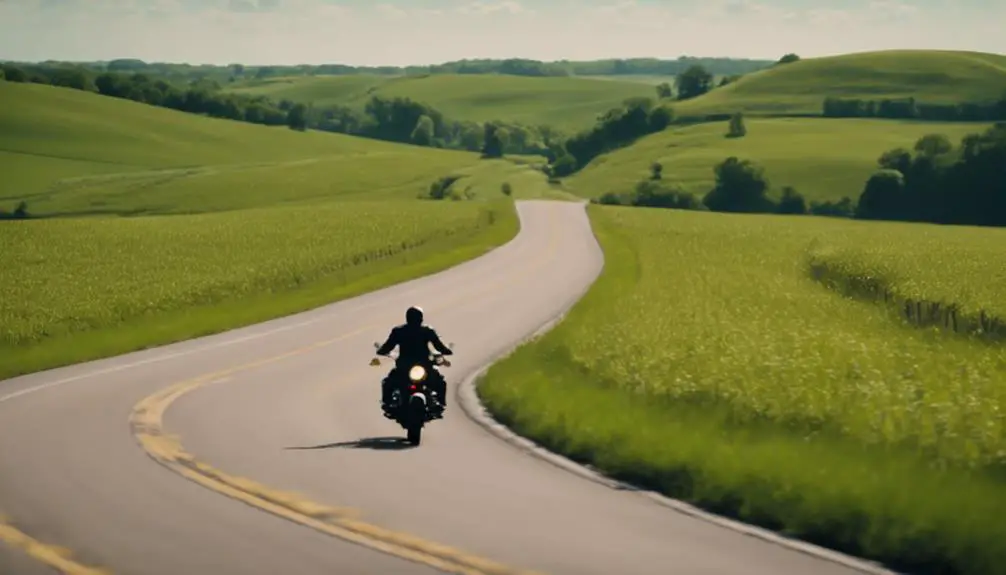Across my years in the industry, I’ve bounced my head of a concrete pole many times in spite of bad gas in a motorcycle. Really – nothing is worse than cleaning up clumps of chunky – formerly liquid – gasoline that smells absolutely outrageous. Yeah, no thanks.
Anyways, in this article I’ll tell you exactly what to look out for so you’re not embarking on a wild goose chase; but I’ll also show you how to fix these problems, and my personal favorite way to clean up your fuel system after. Lets get going!
Related read: Round Em Up: What Year Harleys To Avoid? (Full Overview)

What Are The Symptoms of Bad Gas In A Harley?
Bad gas can cause a variety of issues in your motorcycle by creating problems in the fuel injection system and the fuel pump. If you suspect that your Harley may have bad gas, keep an eye out for the following symptoms:
Poor Fuel Efficiency (If It Runs)
A primary symptom of bad gas in a motorcycle is poor fuel efficiency. If the gas in your Harley is contaminated or degraded, it can result in decreased gas mileage, which can be frustrating for riders who are used to getting good gas mileage.
Strong Smell From The Gas Tank
Bad gas in a motorcycle often produces a strong or rancid odor. This smell may be noticeable when you open the gas cap or when you are close to the fuel tank. If you detect this smell, it could be a sign that the gas in your Harley has gone bad.
Black Smoke From The Exhaust
Another symptom of bad gas in a motorcycle is black smoke coming from the exhaust pipe. This is a sign that the engine is not burning the fuel properly, which can be caused by a buildup of contaminants in the gas.
Decreased Performance
Bad gas can lead to decreased performance in your Harley. If your motorcycle is not running as smoothly or as powerfully as it should be, it could be due to bad gas causing issues within the engine.
Engine Misfiring
Engine misfiring can also be a symptom of bad gas in a motorcycle. This occurs when the engine does not fire properly, resulting in uneven power delivery and a rough ride. This is most commonly described as a sputtering on acceleration.
Rough Idle or Bogging
Bad gas can cause your Harley to have a rough idle or to bog down during acceleration. This is due to the engine not receiving the proper fuel mixture, causing it to struggle and underperform.
Stalling
Stalling is another symptom of bad gas in a motorcycle. If your Harley is stalling frequently or having difficulty starting, it could be due to bad gas affecting the engine’s performance.
Related reads:
– 6 of The Worst Road Glide Years to Avoid (For Your Sanity)
– 4 Dreaded Harley Fatboy Years to Avoid (Really, Trust Me)
– 8 Basket Case Sportster Years to Avoid (For Your Sanity)
– 12 Electra Glide Years to Avoid (For Your Sanity’s Sake)
– 4 Worst Street Glide Years to Avoid If You Value Your Sanity
– 4 of The Worst Road King Years to Avoid + Standouts and More
– Is Harley’s 103 A Good Engine or Not?

Why Does Bad Gas Cause Problems In A Motorcycle?
Bad gas can cause various problems in a motorcycle’s engine and fuel system, leading to decreased performance and potential damage. The issues that arise from bad gas are often due to the following factors:
Ethanol Damage and Fermentation
Ethanol is a common additive in gasoline, but it can cause several problems in a motorcycle’s engine and fuel system. Ethanol attracts water, which can lead to the formation of a mixture that can cause corrosion and damage to the engine and fuel system components.
Furthermore, ethanol can ferment over time, producing a gummy substance that can clog fuel lines, injectors, and carburetors, leading to poor engine performance and potential damage.
Clogged Fuel Lines
Bad gas can contain contaminants such as dirt, rust, and other debris that can clog the fuel lines in your motorcycle. This can restrict the flow of fuel to the engine, causing poor performance and potential engine damage.
Clogged Fuel Injectors
Fuel injectors play a crucial role in delivering the correct amount of fuel to your motorcycle’s engine. Bad gas can cause the injectors to become clogged with debris and contaminants, leading to poor engine performance and potential damage.
Clogged Carburetor
A clogged carburetor is another common issue caused by bad gas. The carburetor is responsible for mixing the right amount of fuel and air for your motorcycle’s engine. If the carburetor becomes clogged with debris and contaminants, it can result in poor engine performance and potential damage.
Gummed Up Fuel Tank
Bad gas can cause your motorcycle’s fuel tank to become gummed up with a sticky residue. This can lead to a restricted flow of fuel to the engine, causing poor performance and potential damage.
Model specific problems:
– 21 Years of Road King Problems To Be Aware Of (No, Really)
– 14 Years of Street Glide Problems To Be Wary Of (No, Really)
– 5 Years of Road Glide Problems To Be Aware Of (No, For Real)
– 13 Painful Years of Harley Davidson Ultra Classic Problems
– 8 Dreaded Years of Harley Davidson Ultra Limited Problems

How To Drain The Gas From A Motorcycle
If you suspect that your motorcycle has bad gas, it’s essential to drain the old gas from the tank and replace it with fresh fuel. To do this, follow these steps:
- Turn off the motorcycle and ensure that it is in a well-ventilated area.
- Locate the fuel line connecting the fuel tank to the engine. You may need to consult your motorcycle’s manual to find the correct location.
- Disconnect the fuel line from the fuel tank, being careful to catch any fuel that may spill out.
- Using a siphon or an external gasoline-rated pump, drain the old gas from the tank into a suitable container. Be sure to dispose of the old gas properly and safely, as it can be hazardous to the environment.
- Once the tank is empty, you may need to clean it to ensure that no residue or contaminants are left behind.
- Be sure to remove any excess moisture as this can lead to what’s known as “flash rusting”
How To Use A Vinegar Cleaning Solution To Clean The Tank
After draining the bad gas from your motorcycle’s fuel tank, you may need to clean it to ensure that any residue or contaminants are removed. A simple and effective way to do this is by using a vinegar cleaning solution. Here’s how:
- Mix equal parts of distilled white vinegar and water in a container. This will create a mild cleaning solution that is safe to use on your motorcycle’s fuel tank.
- Pour the vinegar cleaning solution into the fuel tank until it is full.
- Let the solution sit in the tank for at least 30 minutes to an hour, allowing it to dissolve any residue or contaminants.
- Drain the vinegar cleaning solution from the tank, and rinse it thoroughly with water to remove any remaining debris.
- Allow the tank to dry completely before reconnecting the fuel line and refilling it with fresh gasoline.
Also Removes Rust Along With Ethanol Deposits
The vinegar cleaning solution not only helps to remove ethanol deposits from your motorcycle’s fuel tank but also helps to remove any rust that may have formed. This is especially useful for older motorcycles or those that have been exposed to moisture for extended periods.

Can You Add New Gas To Bad Gas?
It’s not recommended to add new gas to bad gas in your motorcycle’s fuel tank. Mixing fresh gasoline with bad gas can dilute the contaminants, but it won’t completely remove them. Instead, it’s best to drain the bad gas and replace it with fresh fuel to ensure that your motorcycle’s engine and fuel system are free from contaminants and residue.
How Long Does Gas Last?
Gasoline has a limited shelf life and can start to degrade over time. The specific timeframe for gas to go bad depends on factors such as the quality of the gas, the size of the gas tank, storage conditions, and the presence of ethanol. Generally, gasoline can start to go bad in as little as a few weeks to several months. Ethanol-free gasoline typically has a longer shelf life, up to six months or more, while gasoline with ethanol can degrade more quickly.
Why Does Gas Start To Go Bad?
Gasoline is a complex mixture of hydrocarbons, additives, and other chemicals that can degrade over time when exposed to air, heat, and contaminants. Oxidation and the breakdown of the gasoline’s chemical composition can lead to a loss of igniting quality, gumming, and the formation of sediment and debris. These factors can negatively impact the performance of your motorcycle’s engine and fuel system. Be sure to ride your motorcycle when it’s idle for longer periods of time. Also make sure that you don’t have a bad gas cap or it can accelerate these symptoms.

Benefits of Ethanol Free Gas
Using ethanol-free gas in your motorcycle can offer several benefits, particularly for carbureted motorcycles and small engine machines. Some of the advantages include:
- Longer shelf life: Ethanol-free gas has a longer shelf life than gasoline with ethanol, making it a better choice for motorcycles that are not used frequently.
- Better fuel efficiency: Motorcycles running on ethanol-free gas often experience better fuel efficiency, as ethanol can lower the energy content of gasoline.
- Reduced risk of engine and fuel system damage: Ethanol-free gas is less likely to cause corrosion, gumming, and other issues in your motorcycle’s engine and fuel system.
- Improved performance: Many riders report improved performance when using ethanol-free gas in their motorcycles, as it can provide a cleaner and more efficient burn.
By choosing ethanol-free gas for your motorcycle, you can help to protect your engine and fuel system, improve performance, and extend the life of your bike.







Leave a Reply
You must be logged in to post a comment.